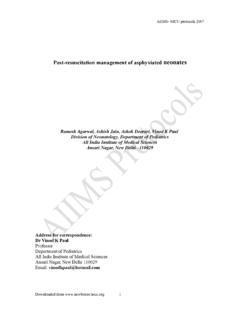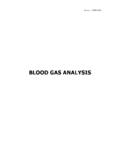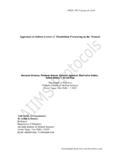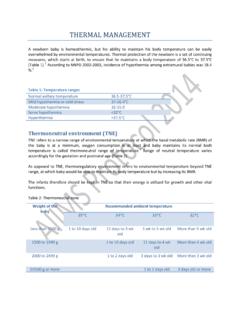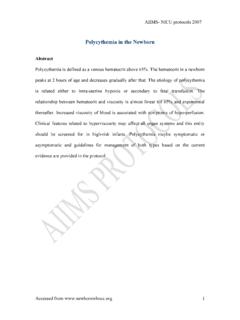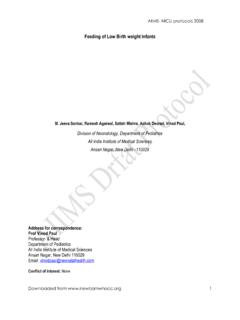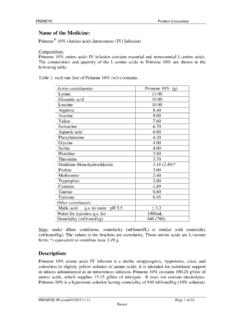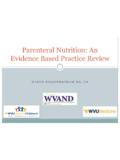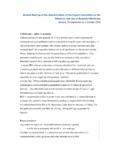Transcription of Hypoglycemia in the newborn period
1 AIIMS- NICU protocols updated 2007. Hypoglycemia in the newborn Ashish Jain, Rajiv Aggarwal*, M Jeevashanker, Ramesh Agarwal, Ashok K Deorari, Vinod K Paul WHO Collaborating Center for Training & Research in newborn Care Division of Neonatology, Department of Pediatrics All India Institute of Medical Sciences Ansari Nagar, New Delhi 110029. * Narayana Hridalaya , Bangalore Address for correspondence: Dr Ramesh Agarwal Assistant Professor Department of Pediatrics All India Institute of Medical Sciences Ansari Nagar, New Delhi 110029. Email: AIIMS- NICU protocols updated 2007. AIIMS- NICU protocols updated 2007 2. Abstract Hypoglycemia in a neonate has been defined as blood sugar value below 40mg/dL. Hypoglycemia is encountered in a variety of neonatal conditions including prematurity, growth retardation and maternal diabetes. Screening for Hypoglycemia in certain high-risk situations is recommended.
2 Supervised breast-feeding may be an initial treatment option in asymptomatic Hypoglycemia . However, symptomatic Hypoglycemia should always be treated with a continuous infusion of parenteral dextrose. neonates needing dextrose infusion rates above 12 mg/kg/min should be investigated for the cause of Hypoglycemia . Hypoglycemia has been linked to poor neuro-developmental outcome, and hence aggressive screening and treatment is recommended. Downloaded from AIIMS- NICU protocols updated 2007 3. Introduction Hypoglycemia is a common ,2 There is still no universal definition for this Koh et al did a detailed survey and found that the definitions ranged from 18 mg/dL to 72. Confusion exists due to the fact that the normal range of blood glucose is different for each newborn and depends upon a number of factors including birth-weight, gestational age, body stores, feeding status, availability of energy sources as well as the presence or absence of ,6.
3 Thus the definition of Hypoglycemia should be flexible and encompass all these aspects. Further, there is no concrete evidence to show the causation of adverse long-term outcomes by a particular level or duration of Hypoglycemia . 7 A recent consensus has been to evolve an operational threshold . Definition The operational threshold for Hypoglycemia is defined as that concentration of plasma or whole blood glucose at which clinicians should consider intervention, based on the evidence currently available in This threshold is currently believed to be a blood glucose value of less than 40 mg/dL (plasma glucose less than 45 mg/dL). Screening for Hypoglycemia Normal blood glucose levels are maintained by Neonatal Hypoglycemia most commonly occurs in infants with impaired gluconeogenesis, brought about by increased insulin production, altered counter-regulatory hormone production or an inadequate substrate supply.
4 Screening for Hypoglycemia is recommended in the following high risk infants. Table 1: High risk situations where screening is recommended 1 Low birth weight infants (<1800 grams). 2 Preterm infants ( 35 weeks). 3 Small for gestational age infants (SGA) : birth weight <10th percentile 4 Infant of diabetic mothers (IDM) -insulin dependent and gestational diabetes 5 Large for gestational age (LGA) infants with birth weight >90th percentile. Some doubt Downloaded from AIIMS- NICU protocols updated 2007 4. has been raised as to whether LGA infants who are not IDMs are truly at risk8. 6 Infants with Rh-hemolytic disease 7 Infants born to mothers receiving therapy with terbutaline/propranolol/oral hypoglycemic agents 8 Infants with morphological growth retardation. This group includes neonates with birth weight between 10th 25th percentile with features of fetal under-nutrition such as three or more loose skin folds in gluteal region, decreased overall subcutaneous fat, and head circumference to chest circumference difference more than 3 cm 9 Any sick neonate such as those with perinatal asphyxia, polycythemia, sepsis, shock etc, when they are in active phase of illness.
5 The screening may be discontinued once their condition gets stabilized. 10 Infants on total parenteral nutrition Infants in whom screening is not required Screening for Hypoglycemia is not recommended in term breast-fed appropriate-for-gestational age (AGA) infants. However term babies with poor feeding, presence of inadequate lactation or presence of cold stress may be considered for screening. Method of Glucose estimation a. Reagent strips (Glucose oxidase): Though widely used and are important point of care'. method, they are unreliable especially, at blood glucose levels less than 40-50mg/dL. They are useful for screening purpose but low values should be always confirmed by formal laboratory analysis, before a diagnosis of Hypoglycemia is made ( however treatment must be instituted based on results of reagent strips). It is important to also consider the variations between capillary and venous, blood and plasma, and immediate and stored samples (whole blood sugar is 10-15% less than the plasma sugar, the glucose levels can fall by 14-18 mg/dL per hour in blood samples that await the ).
6 B. Laboratory diagnosis: This is the most accurate method. In the laboratory (lab), glucose can be measured by either the glucose oxidase (calorimetric) method or by the glucose electrode method (as used in blood gas & electrolyte analyser machine).. Blood samples should be analyzed quickly to avoid erroneously low glucose levels. Downloaded from AIIMS- NICU protocols updated 2007 5. Clinical signs associated with Hypoglycemia a. Asymptomatic: It is also well known that low blood glucose may not manifest with any sign and may be totally asymptomatic. These babies should also be treated in view of possible adverse long term ,11. b Symptomatic: Clinical signs of Hypoglycemia in approximate order of frequency are stupor ,jitteriness, tremors, apathy, episodes of cyanosis, convulsions, intermitant apneic spells or tachypnea, weak and high pitched cry, limpness and lethargy, difficulty in feeding, and eye rolling.
7 Episodes of sweating, sudden pallor, hypothermia and cardiac arrest have also been reported Diagnosis a. Asymptomatic Hypoglycemia : This diagnosis is made when the blood glucose level is below the operational threshold (to be confirmed by laboratory estimation) in the absence of clinical signs. b. Symptomatic Hypoglycemia : This diagnosis should be made if Hypoglycemia coexists with clinical symptomatology. neonates generally present with nonspecific signs that result from a variety of illnesses. Therefore, careful evaluation should be done to look for all possible causes especially those that can be attributed to Hypoglycemia . If clinical signs attributable to Hypoglycemia persist despite intravenous glucose, then other diagnostic possibilities should be strongly considered. Time schedule for screening There is a paucity of the literature that looks into optimal timing and the intervals of glucose monitoring.
8 Lowest blood sugar values are seen at 2 h. IDMs frequently experience asymptomatic Hypoglycemia very early viz 1 to 2 hours and rarely beyond 12 hours (range to h), supporting early screening for this population. However, preterm and SGA may be at risk up to 36 h (range to h).12 Few SGA and preterms may develop Hypoglycemia when feeding is not established. Based on these assumptions and current knowledge, Table 2. elaborates the schedule and frequency of monitoring in different situations Downloaded from AIIMS- NICU protocols updated 2007 6. Table 2: Schedule of blood glucose monitoring Symtamatology of babies Time schedule for screening At risk neonates 2. 6. 12. 24, 48, 72 h ( 1-8 in Table no 1). Sick babies 6-8 h Sepsis, asphyxia, shock in (individualize as needed). the active phase of illness Stable VLBW babies on Once/day, after intial 72 h (in initial 3 days frequency as parenteral nutrition for at risk babies).
9 Growing VLBW babies Once a week, as a part of weekly work-up Asymptomatic babies with After 1 hour of oral /fortified feed, Later every 6 hrs till 48. blood sugar levels between h if blood sugar levels > 50mg/dL. 20-40 mg/dL on screening Asymptomatic babies with After 1 hour of starting IV fluids and then every hour blood sugar levels below ( after every stepwise augmentation of GIR by 2. 20mg/dL mg/kg/min till blood sugars remain below 50 mg/dL). Asymptomatic with blood Once the blood sugar levels are above 50 mg/dL they are sugar levels below 40mg/dL monitored every 6 h for 48 h even after 1 hour of fortified/oral feeds Symptomatic babies Babies exhibiting signs compatible with Hypoglycemia at any time also need to be screened..Education and counseling of caregivers regarding the screening Parents should be made aware that their baby is symptomatic or at-risk and therefore requires blood tests at regular intervals.
10 This will ensure appropriate parental participation in monitoring and allay fears if further interventions are required. Screening is stopped At the end of 72 hours in at risk babies (Table no 1). An infant after stopping of the IV fluids and has two consecutive values >50 mg/dL on total oral feeds Management of asymptomatic Hypoglycemia Downloaded from AIIMS- NICU protocols updated 2007 7. Table 3: Management plan of babies with asymptomatic Hypoglycemia on screening Blood sugar 20-40 mg/dL Trial of oral feeds/fortified feeds (prepared by adding 5g sugar in 100ml or by constituting formula in 5% dextrose instead of water) and repeat test after 1 hour. If repeat blood sugars are above 40 mg/dL, 2nd hourly feed is ensured with 6 hrly monitoring for 48 hrs If repeat blood sugars are < 40mg/dL than IV fluids are started and the management is as for symptomatic Hypoglycemia Blood sugar levels < 20 mg/dL IV fluid are started at 6 mg/kg/min of glucose , the further management is as for symptomatic Hypoglycemia Oral feeds issues Direct breast-feeding is the best option for a trial of an oral feed.
